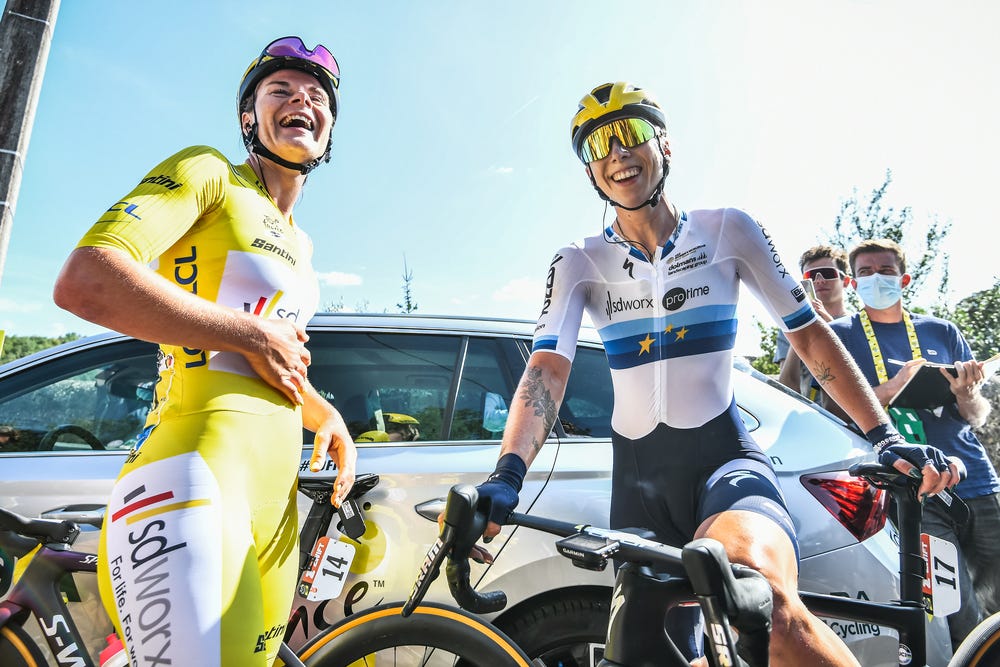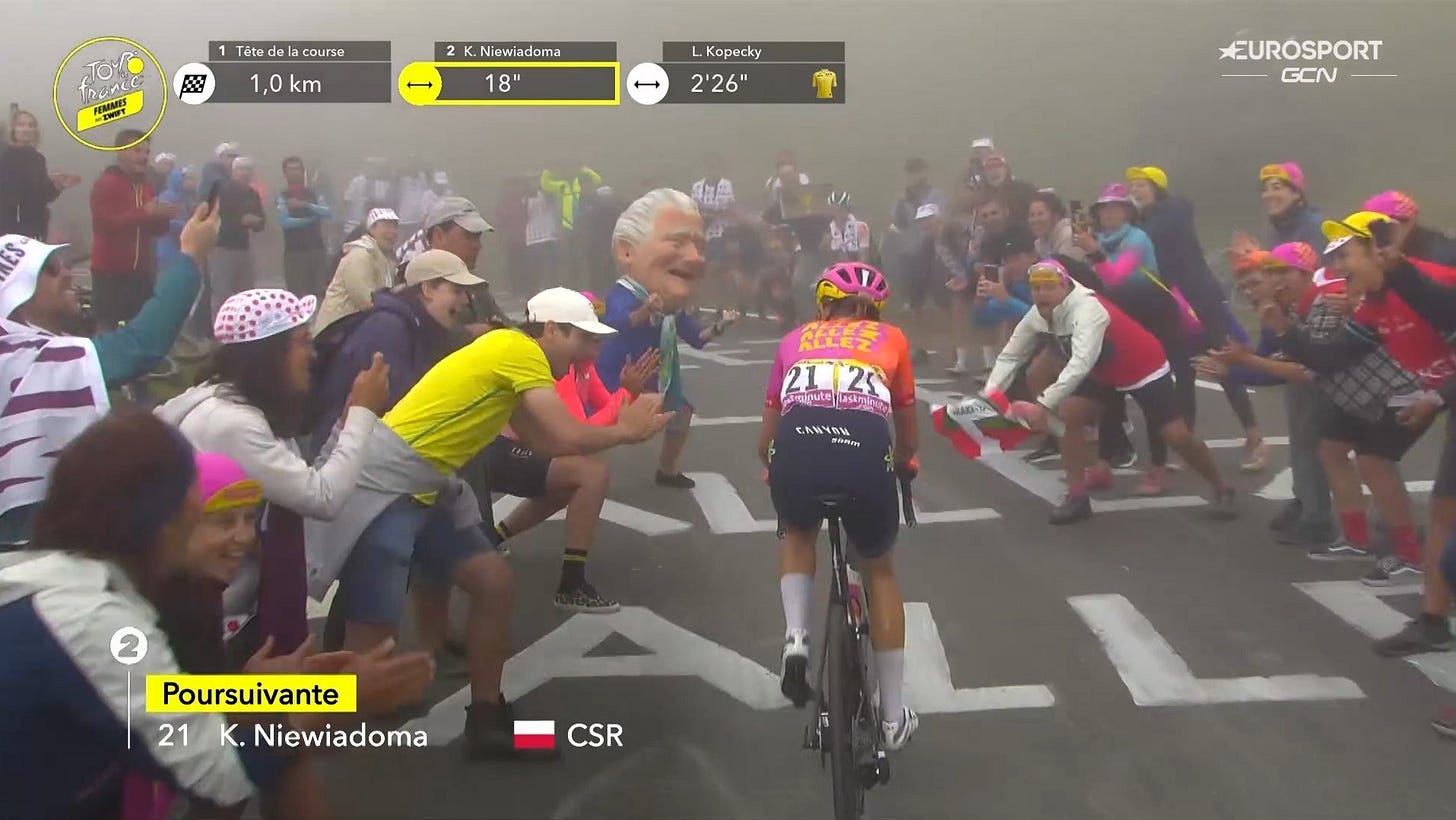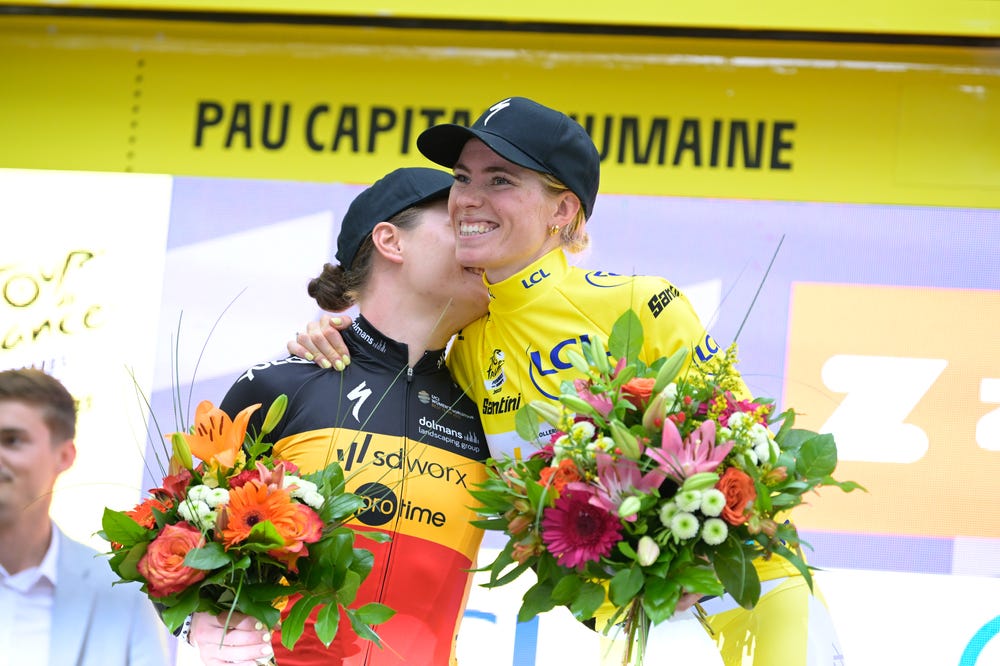Can, or Should, SD Worx Be Stopped?
The best team in cycling can't stop winning. And despite what you might think, it's doing women's cycling a favor.
I don’t pay a ton of attention to UCI rankings points, but I can’t think of a better way to present this argument. Here are the top five riders in the Women’s World Tour over the past 12 months, according to ProCyclingStats.
Demi Vollering, Netherlands, SD Worx, 3602 points
Lotte Kopecky, Belgium, SD Worx, 2498 points
Lorena Wiebes, Netherlands, SD Worx, 1970 points
Marlen Reusser, Switzerland, SD Worx, 1905 points
Annemiek Van Vleuten, Netherlands, Movistar, 1873 points
Van Vleuten retired at the end of this past season. It’s even worse than it looks.
It won’t surprise you to learn, then, that SD Worx also won its seventh team points title in eight years, with almost as many points as the next two outfits put together. SD Worx won 14 of the 27 races on the World Tour calendar, 13 of those courtesy of the four riders listed above.
The top four riders on SD Worx each won a stage of the Tour de France, plus the GC and the points jersey. Also two monuments, Strade Bianche, La Flèche Wallonne and Amstel Gold Race (Vollering took those two and Liège-Bastogne-Liège in the span of a week to complete the famed Ardennes triple). SD Worx also took first place in Omloop Het Niewsblad, Gent-Wevelgem, Tour of the Basque Country, Tour de Suisse, Vuelta a Burgos, the world road race championship, the European time trial championship, and the European road race championship, where Wiebes and Kopecky completed a podium lockout behind teammate Mischa Bredewold.
There were two ways SD Worx lost big races in 2023. The first was Paris-Roubaix, where everything went wrong. A big breakaway got out in front to start the stage, then the peloton split up, then a crash put Wiebes and Kopecky on the ground. When they got back up everyone was so scared of the SD Worx duo that nobody would help them chase down the break. Alison “Action” Jackson, a 34-year-old Canadian bucket hat enthusiast, won the decisive sprint, dismounted her bike and (touches earpiece) I believe the term is…“hit the griddy.” I think. I don’t know what the griddy is.
The second way SD Worx can lose a race is a superhuman performance by van Vleuten, who won the Giro and the Vuelta and has a case for being the best women’s road cyclist of all time. And again, van Vleuten is now retired.
There used to be a third way for SD Worx to lose: Infighting. If you don’t think van Vleuten is not the best women’s road cyclist ever, you might go with Anna van der Breggen, who was the team leader until she retired two years ago at age 31. (Van der Breggen is now an SD Worx directeur sportif. Which I’m pretty sure doesn’t get feminized to directeuse sportive, but my French is extremely rusty.)
During their one year as teammates, there would occasionally be some confusion from race to race over whether van der Breggen or Vollering would take the lead in important races. But this current quartet complements each other perfectly.
Vollering is one of the best climbers in the peloton and nearly unbeatable on hilly terrain. Reusser is an elite time trialist and a huge engine on flat ground. Wiebes is the fastest sprinter in the peloton, and Kopecky can lead out for Wiebes, help Reusser set tempo, and set up Vollering at the base of a climb.
Their strengths overlap enough that SD Worx has one of the favorites for every race, but not so much that there’s not a clear leader within the team. In a sport like cycling, or motor racing which operates on a team basis but crowns an individual winner, even intra-team alliances can be fragile. You know this if you follow Formula 1, or if you remember Alberto Contador’s time as Lance Armstrong’s teammate, or Greg LeMond’s time as Bernard Hinault’s, or you’re just generally aware of the Movistar men’s team.
The closest SD Worx came to a real leadership crisis was at the Tour de France Femmes, where Kopecky took yellow early in the race and climbed better than expected up the Col du Tourmalet. That iconic climb, made all the more mysterious by fog and mountain people with enormous noggins.
SD Worx let Kopecky off the leash, but Vollering zoomed off into the distance to win the stage by two minutes and take the race lead. She and Kopecky finished 1-2 on GC, and everyone seemed fine with the outcome.
Or at least Vollering did. I think Kopecky’s smiling there, but maybe she’s afraid she’s about to be smothered to prevent future borrowings of the yellow jersey.
And with van Vleuten no longer around to fight off this superteam single-handed, I expect more dominance from SD Worx in 2024. Particularly because former world champion Chantal van den Broek-Blaak is back after taking last season off to have a baby; Bredewold is still young and improving, as is Kiwi climber Niamh Fisher-Black.
If you’ve followed other women’s sports before, you know where this is going. Is it bad for the sport to have one team dominate the way SD Worx does?
And here I’m going to give a slightly un-PC answer, but don’t hang I promise it’s for a good reason: Of course it’s bad to have one team dominate. At least in the short term.
That’s not the orthodox answer when it came to UConn women’s basketball, or the Williams sisters, or the U.S. women’s soccer team. (Though I don’t think anyone in the U.S. press really cared that much about the USWNT dominating; American sports fans like concern-trolling about the long-term solvency of women’s sports, but we love getting one over on those smug-ass Europeans.)
But in a tournament, like March Madness or the World Cup or the U.S. Open, it’s OK to have a one-competitor-versus-the-field vibe. Because no matter how heavy the favorite, they’re always just one mistake away from elimination, and people who are rooting for them to lose almost don’t care who they lose to or how.
Cycling has important individual events, and at any one race SD Worx is vulnerable. But the season as a whole is a bit repetitive, because it comprises dozens of discrete but similar events. And over a long enough timeline, the favorite can win frequently enough to make the season as a whole kind of a drag. Again, a Formula 1 comparison: After bringing in millions of new eyeballs for an all-time great title fight in 2021, F1 has followed that up by two years of complete dominance by one team. And there’s no end in sight. If fans aren’t already turned off by knowing in advance who’ll win the race, they will be soon.
With all that said, it’s not SD Worx that’s fucking things up for everyone else. It’s everyone else’s fault that SD Worx got this far ahead.
Women’s road cycling is every bit as fun and interesting as men’s, when it’s given a chance. But too often it’s given only token consideration. There are obvious things, like, women’s races scrapping for TV coverage or the lack of shut-the-hell-up from leading cycling figures like Patrick Lefevre. Even the fact that it seems like every women’s team has cool-looking uniforms in isolation, then you zoom out and realize that almost all of them are in some shade of pink, purple, or baby blue—girly colors—so it’s hard to tell who’s who.
These issues effect every team, even SD Worx, which under previous sponsorship raced in various ungendered configurations of black and orange but now wears sort of a grapefruitish kit. But the schedule is the real key.
Vollering is an absolute monster, to be sure, but if the Women’s World Tour were structured like the men’s, she would not be winning every race. The Women’s World Tour has fewer races, fewer teams, fewer riders on each team roster, and fewer riders per team in each race. Therefore a star rider, like Vollering or Kopecky, races a higher percentage of her team’s events than does a comparable male rider. And when she does, she makes up a greater percentage of the peloton. That means there are fewer teams with which to compete, and those teams don’t have as many riders with which to throw tactical wrinkles at the favorites.
More than that, race organizers don’t test female riders with proper grand tours. The men’s Tour de France is 21 stages; the women get eight. Of those eight last year, only the final two were proper GC-testing stages: the individual time trial and the queen stage up the Tourmalet. And even that was less than 100 kilometers, with one outside-category climb and one first category climb. (The queen stage of a men’s grand tour could have as many as three or four such climbs.)
Vollering is a superb puncheur, born to do things like the Ardennes triple. But in the men’s game, with its deeper rosters and longer calendar, Liège-Bastogne-Liège and the Tour de France are almost different disciplines. Only two male riders have won both races in the past 40 years.
Could Vollering survive three weeks with half a dozen stages that include multiple high-altitude climbs? I have no idea. Neither does anyone else. There’s probably a pure climber out there who could get over the Alps better than Vollering and recover well enough to do it again the next day, but the race calendar doesn’t really offer an opportunity for her to prove it. And even if she could, almost nobody on the men’s side has the stamina to contest multiple three-week grand tours in a single season; van Vleuten, needing only to last a week each time out, won multiple grand tours every season of her career in which it was possible to do so.
There are riders and teams on the men’s side who flirt with the so-good-it’s-almost-boring label within a certain discipline. But across the season, it’s impossible to optimize a roster for every race, even with as many as 30 riders to pick from. Because the UCI gives the women basically a classics schedule with a couple one-week stage races, SD Worx can optimize for every race with just four riders: Vollering, Kopecky, Wiebes, and Reusser.
They can do this because nobody else is challenging them. Certainly not the UCI or race organizers, and not the other teams. And here’s where the bad-for-the-sport label gets a little nuanced.
None of this is SD Worx’s problem.
Most of the 16 teams on the women’s World Tour are appendages of an established men’s team, either through shared ownership and management or branding. And they frequently get treated that way.
Not always—I keep looking at Lidl-Trek’s roster and wonder why a team with that much talent can’t take bigger chunks out of SD Worx—but frequently.
SD Worx is its own thing. And it wins because it spends to poach winning riders from other teams, enough to put together the best roster in the sport. None of the big four came up through the SD Worx junior system; all of them were poached from other teams within the past three years.
It frustrates me when people see competitive imbalance and think the solution is to peg back the teams that are doing it better. Last week, when I was covering the Shohei Ohtani free agency process I had people saying the Dodgers were out of control and MLB needed a salary cap.
Subsidizing mediocrity only incentivizes mediocrity. Letting a great team with great talent and great resources be great, that incentivizes competitors to figure out how to beat them. Whether through tactical innovation, coaching, or sheer financial brute force, someone always will. To cycle back to the women’s college basketball example: Pat Summitt led to Geno Auriemma led to Dawn Staley. Eventually the next cycle will come along. SD Worx isn’t breaking the sport, it’s setting a standard.
So is it a little repetitive to watch Vollering sprint off into the sunset whenever the road goes uphill? I guess. But when someone finally figures out how to stop her—either by beefing up the schedule or putting together a team to rival SD Worx—it will be a sport-changing step forward.







